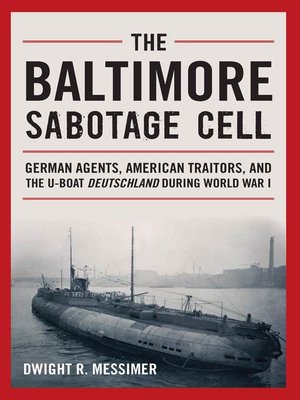The Baltimore Sabotage Cell
ebook ∣ German Agents, American Traitors, and the U-boat Deutschland During World War I
By Dwight R Messimer

Sign up to save your library
With an OverDrive account, you can save your favorite libraries for at-a-glance information about availability. Find out more about OverDrive accounts.
Find this title in Libby, the library reading app by OverDrive.



Search for a digital library with this title
Title found at these libraries:
| Library Name | Distance |
|---|---|
| Loading... |
By the summer of 1915 Germany was faced with two major problems in fighting World War I: how to break the British blockade and how to stop or seriously disrupt the British supply line across the Atlantic. Th e solution to the former was to find a way over, through, or under it. Aircraft in those days were too primitive, too short range, and too underpowered to accomplish this, and Germany lacked the naval strength to force a passage through the blockade. But if Germany could build a fleet of cargo U-boats that were large enough to carry meaningful loads and had the range to make a round trip between Germany and the United States without refueling, the blockade might be successfully broken. Since the German navy could not cut Britain's supply line to America, another answer lay in sabotaging munitions factories, depots, and ships, as well as infecting horses and mules at the western end of the supply line. German agents, with American sympathizers, successfully carried out more than fifty attacks involving fires and explosions and spread anthrax and glanders on the East Coast before America's entry into the war on 6 April 1917. Breaking the blockade with a fleet of cargo U-boats provided the lowest risk of drawing America into the war; at the same time, sabotage was incompatible with Germany's diplomatic goal of keeping the United States out of the war. The two solutions were very different, but the fact that both campaigns were run by intelligence agencies—the Etappendienst (navy) and the Geheimdienst (army), through the agency of one man, Paul Hilken, in one American city, Baltimore, make them inseparable. Those solutions created the dichotomy that produced the U-boat Deutschland and the Baltimore Sabotage Cell. Here, Messimer provides the first study of the degree to which U.S. citizens were enlisted in Germany's sabotage operations and debunks many myths that surround the Deutschland.







